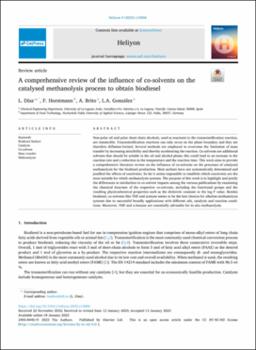A comprehensive review of the influence of co-solvents on the catalysed methanolysis process to obtain biodiesel
Date
2023Abstract
Non-polar oil and polar short-chain alcohols, used as reactants in the transesterification reaction,
are immiscible. Transesterification reactions can only occur on the phase boundary and they are
therefore diffusion-limited. Several methods are employed to overcome the limitation of mass
transfer by increasing miscibility and thereby accelerating the reaction. Co-solvents are additional
solvents that should be soluble in the oil and alcohol phase; this could lead to an increase in the
reaction rate and a reduction in the temperature and the reaction time. This work aims to provide
a comprehensive literature review on the influence of co-solvents on the processes of catalysed
methanolysis for the biodiesel production. Most authors have not systematically determined and
justified the effects of cosolvents. So far it seems impossible to establish which cosolvents are the
most suitable for which methanolysis systems. The purpose of this work is to highlight and justify
the differences or similarities in co-solvent impacts among the various publications by examining
the chemical structure of the respective co-solvents, including the functional groups and the
resulting physicochemical properties such as the dielectric constant or the log P value. Besides
biodiesel, co-solvents like THF and acetone seems to be the best choices for alkaline methanolysis
systems due to successful broadly applications with different oils, catalysts and reaction conditions. Moreover, THF and n-hexane are essentially advisable for in-situ methanolysis.






